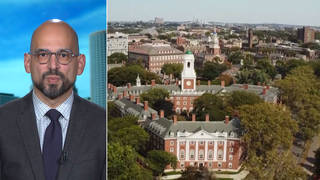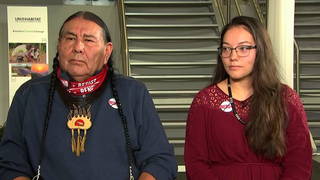
Topics
Guests
- John Weisheitconservation director of Living Rivers & Colorado Riverkeeper.
- Ashley Andersonfounder and director of Before It Starts, which is leading the fight to stop tar sands drilling in Utah. He is also the co-founder and former director of Peaceful Uprisings, which he began with activist Tim DeChristopher.
As a direct action blockade of the construction of the Keystone XL pipeline continues in Texas, we look at what could be the first actual tar sands and oil shale strip-mining operation in the United States. Not far from Moab, Utah, the state has already leased land to a Canadian energy development company that recently changed its name to U.S. Oil Sands. The company plans to mine nearly 6,000 acres in an area of unspoiled wilderness that is also the watershed of the Colorado River, which provides water to more than 30 million people. The mine itself would be water-intensive in what is already the second-driest state in the country, and activists say chemicals used in the mine could pollute the water that is left. We’re joined by two activists working to block the project: John Weisheit, longtime conservation director of Living Rivers & Colorado Riverkeeper; and Ashley Anderson, founder and director of Before It Starts, which is leading the fight to stop tar sands drilling in Utah. [includes rush transcript]
Transcript
AMY GOODMAN: We’re on the road in Durango, Colorado. With less than 30 days before the election, we turn to look at tar sands oil, the subject of promises by both major presidential campaigns, even as they avoid the issue of climate change.
On Monday, Republican vice-presidential candidate Paul Ryan vowed to approve the Keystone XL pipeline that would run the thick crude oil from Canada to the U.S. refineries in Texas. Addressing supporters in Ohio, he said, if elected, Romney would approve the pipeline on his first day in office, and blamed President Obama for standing in the way of jobs the project could bring.
Obama has delayed a final decision on the pipeline until after the November election. But TransCanada is already clearing the way for its southern leg in Texas, drawing protests from activists who say spills along its path could poison communities. They call the pipeline the fuse to the largest carbon bomb on the planet. For more than two weeks, they’ve held a tree-sit to block its path near Winnsboro, Texas. Meanwhile, on Thursday, actress Daryl Hannah and a 78-year-old East Texas farmer were arrested while protesting the clearance [of] her land seized by eminent domain. This is Eleanor Fairchild speaking as she stared down one of the TransCanada bulldozers.
ELEANOR FAIRCHILD: I am mad. This land is my land, and it’s been our land since '83. Our home is on it. They're going to destroy the woods, and also they could destroy the springs. It’s just devastating, but it also is not very good to have the tar sands anywhere in the United States. This is not just about my land; it’s about all of our country.
AMY GOODMAN: Well, as the tar sands blockade continues in Texas, we look now at what could be the first actual tar sands and oil shale strip-mining operation in the United States. Not far from where we were yesterday in Moab, Utah, the state has already released land to a Canadian energy development company that recently changed its name to U.S. Oil Sands. The company plans to mine nearly 6,000 acres in an area of unspoiled wilderness that’s also the watershed of the Colorado River, which provides water to more than 30 million people. The mine itself would be water-intensive in what’s already the second-driest state in the country, and activists say chemicals used in the mine could pollute the water that’s left.
For more, we’re joined here in Durango, Colorado, just a few hours from the proposed site, from two Moab activists working to block the project. John Weisheit is the longtime conservation director of Living Rivers & Colorado Riverkeeper. And Ashley Anderson is founder and director of Before It Starts, which is leading the fight to stop tar sands drilling in Utah. He’s the former director of Peaceful Uprisings, a group he founded with activist Tim DeChristopher, who I understand is listening to this program on KDUR, the station that broadcasts where he is imprisoned.
But I want to start with John Weisheit. John, explain—when people hear “tar sands,” they think Canada, Alberta. They may think dirty oil, or if they’re Paul Ryan, they think jobs. But talk about why you’re talking about it in Moab.
JOHN WEISHEIT: Well, we’re concerned because this particular locality is in a high-elevation place called the Tavaputs Plateau, and it’s one of the last wild places in Utah. It’s a huge refuge for elk and deer. It’s also a beautiful watershed. It not only would affect the Colorado River, but it also—at this particular site, it’s at the top of the drainage, so it would also affect the White River and the Green River. And so, this is an inappropriate activity. People probably aren’t aware that Utah has a lot of tar sands. It’s exposed at the surface. It’s easy to get to. This would be a strip-mining project. It would completely deforest this high plateau. It would completely annihilate the vegetation for these animals. And it would actually—once they’re done, it would never have any kind of beneficial use whatsoever, besides destroying the watershed.
AMY GOODMAN: So, where did these tar sands come from?
JOHN WEISHEIT: There used to be a lake here. The Colorado River actually was a river system that didn’t make it to the ocean. It drained interiorly, and there were these big, huge lake deposits with algae and leaf litter, and these are the organic material that provided these hydrocarbons.
AMY GOODMAN: I want to turn to a clip from the CBC’s report on the Utah tar sands. This is a report on the Utah Tar Sands Project. According to Earth Energy Resources—since renamed U.S. Oil Sands—there’s now a revolutionary clean technology involving, of all things, oranges.
CBC REPORTER: If you can get all this bitumen out of the ground, separate the oil from the sand, and then put all the land back where it came from—cleanly—that’s exactly what the Calgary company behind this project says it can do, with a secret formula, incredibly, involving something you can find at any grocery store: these. That’s right, oranges! It’s a recipe concocted by the upstart Albertans, who say they can keep Utah beautiful while mining for oil.
GLEN SNARR: That’s actually about almost two million barrels a day of—or a year of production using three units out of that pit.
CBC REPORTER: Company president Glen Snarr says his patent-pending process with, yes, citrus extract does the unthinkable: it takes oil from the sand, leaving no pools of toxic waste, and will not permanently scar the land.
GLEN SNARR: Our long-term environmental footprint is almost nil, and I can say that with a high degree of confidence.
CBC REPORTER: This company video shows a test run. The only byproduct: the sand itself, later used to relandscape the pits they dig. Snarr calls it “beach clean.”
GLEN SNARR: If we can’t do it, then we’ll fold up our tent and go back to Canada.
AMY GOODMAN: John Weisheit, can you talk about the citrus solution?
JOHN WEISHEIT: Well, yes. It’s called D-limonene. It’s a terpene. It’s kind of like pine needles make turpentine. And this is the solvent that they want to mix in with hot water to liberate the bitumen in the materials that they strip-mine from the plateau. And what our concern is, is that once this chemical liberates the hydrocarbons, it also liberates all the nasty chemicals and cancer-producing things within the processing system, which are going into the waste sand, which is going into unlined pits. And with all the broken-up sand and rubble and the very intense cloudbursts that are in the area, what happens is, is the rainwater will percolate into these, releasing and picking up the chemicals and putting them into the local aquifers near the surface, and it would also put it into the streams that would carry them to the Green, Colorado or White River, depending on where they’re locating their mining operation.
AMY GOODMAN: Are tar sands activists working on the Keystone XL aware of what’s going on in Moab? And what do you make of what Paul Ryan says, when he says he will jump-start the Keystone XL pipeline if he were vice president?
JOHN WEISHEIT: Well, I think people are aware of what’s going on in Utah, but it is a mining operation that hasn’t begun yet. And there are activists working on it, and it is in litigation. But I would like the country to know that we aren’t prevailing in the court system, and it is highly likely that this operation will begin in either 2013 or 2014.
AMY GOODMAN: I want to talk about uranium now and uranium mining and uranium milling. Please lay out the story.
JOHN WEISHEIT: Well, Moab used to be called the uranium capital of the world. And in the '50s and ’60s, it was our main economic force in Moab. We also have the second-largest uranium waste pile in the United States, and it's right next to the Colorado River. There was a time when the Department of Energy was going to cap this mining activity in place near the Colorado River, but thanks to California water managers, such as the Metropolitan Water District, we were able to convince the Department of Energy to move the pile away from the Colorado River floodplain. But, in 1984, the uranium industry fell, and—but its prices dropped. The government refused to subsidize the industry any further. But there’s been a resurgence due to an increase in uranium prices. So there are two companies, Denison and Energy Fuels—they’ve actually merged. They’re currently using a milling facility about 100 miles south of Moab. It’s the only uranium-processing facility in the United States, and so whatever uranium mining is happening is happening here in southeastern Utah.
AMY GOODMAN: As Democracy Now! travels on this 100-city tour, we follow the uranium trail from one proposed mine in Virginia, amazingly, to another one near Green River, Utah. Later this week we’ll be in Los Alamos, the birthplace of the Nuclear Age, the atomic bombs used in World War II developed there. I want to play a comment from Dan Chancellor, who is running for a seat on the local San Miguel County Commission. I met him when I was in Telluride, and he was talking about a proposed uranium mill in Paradox, Utah.
DAN CHANCELLOR: Well, we’ve got some development on the valley floor here that’s an issue. And we have the Piñon Ridge mill, the uranium mill. And I’ve come out very strongly—
AMY GOODMAN: What is it?
DAN CHANCELLOR: The Piñon Ridge uranium mill.
DENIS MOYNIHAN: Piñon.
AMY GOODMAN: Piñon Ridge.
DAN CHANCELLOR: Piñon Ridge.
AMY GOODMAN: What’s the uranium mill?
DAN CHANCELLOR: Well, they’re getting ready to put a uranium mill near Paradox.
AMY GOODMAN: Why are you against it?
DAN CHANCELLOR: Well, I’m—couple of things. One, I think it’s bad for the economy, because typically what happens is they bring—they bring people in from other places. And then, when the mill closes down, we’ve got that many more unemployed people with no sense of community. But also, the prevailing winds come straight from there to Telluride, and it’s less than 60 miles away. Their high-tech solution to keeping those particles from blowing into our lungs is spraying water on them. They’re using our water to—you know, they’re basically taking our water to do it. My father grew up in a house in Grand Junction that was built on uranium tailings, and he died when he was 58 years old of a type of cancer that’s typically associated.
AMY GOODMAN: What kind of cancer?
DAN CHANCELLOR: It was a lung cancer, but it’s typically—I mean, that particular type of cancer is typically associated with radiation. I mean, the doctor asked him—his oncologist asked him if he had worked in the uranium industry.
AMY GOODMAN: Wow.
DAN CHANCELLOR: And he hadn’t. But I think we need to protect people’s health and safety, and save the environment.
JOHN WEISHEIT: Yeah.
AMY GOODMAN: That was Dan Chancellor, running for a seat on the local San Miguel County Commission, speaking about this uranium mill in Paradox, Colorado. He was speaking to us in Telluride. John, the significance of this?
JOHN WEISHEIT: Well, it’s on the Dolores River, and it’s going to require Colorado River water. It’s also a very sensitive area. The Dolores River is basically a river that doesn’t flow anymore because of McPhee Reservoir. We’re partnering with a group in Telluride called the Sheep Mountain Alliance. We’ve actually been able to have this under review again. And so, it’s—we really don’t want to see this. We have a legacy of uranium waste and carnage, and we want—our communities want this out of the way. We want it to be part of the history, not the future.
AMY GOODMAN: Ashley Anderson, the activism you’re involved with, from uranium to tar sands? And if you could quickly mention—we have less than a minute—Tim DeChristopher and what’s happening with him.
ASHLEY ANDERSON: Sure. Well, I’d just like to say that what we’re trying to do is stop the fossil fuel industry in its tracks from spreading the way it’s done damage in Canada. There’s a great group called Utah Tar Sands Resistance that’s working on it in Utah. But nationally, we need a big movement to come in and help in the way that we did with the Keystone XL pipeline. We also need to make it obsolete. So that’s how we’re going to kind of preserve our future.
And if you want me to mention Tim, he’s probably listening, and he’ll be getting out on October 24th and serving the rest of his sentence from a halfway house. So, we’ll be able to see him.
AMY GOODMAN: And he was sentenced for two years for?
JOHN WEISHEIT: By the Obama administration, basically, for disrupting a BLM oil and gas lease auction.
AMY GOODMAN: A Bureau of Land Management.
JOHN WEISHEIT: Yeah, gas lease auction to sell off our public lands for oil and gas exploration. So, when you talked about the presidential candidates, I don’t think we’re looking at a good choice when it comes to either candidate preserving a livable future for ourselves.
AMY GOODMAN: Well, Ashley Anderson and John Weisheit, I want to thank you very much for being with us. That does it for our broadcast. We are on our 100-city tour. Tonight we’ll be in Taos. Tomorrow we’ll be in Santa Fe. And then we’ll be in Los Alamos, and we’re moving on to Arizona.













Media Options